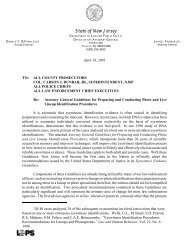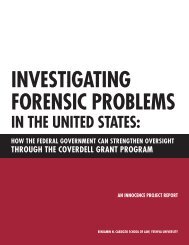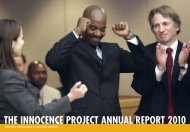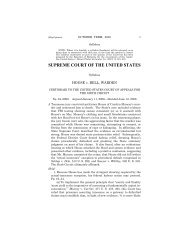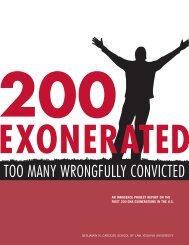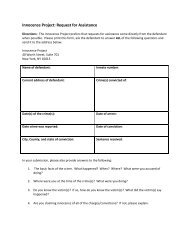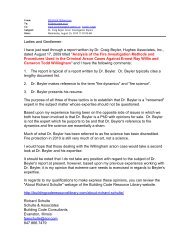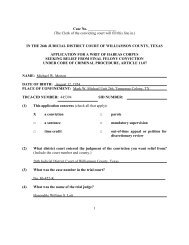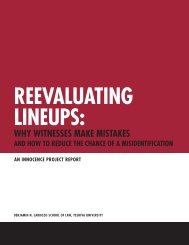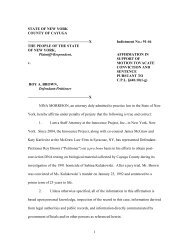John Lentini presentation at Court of Inquiry hearing
John Lentini presentation at Court of Inquiry hearing
John Lentini presentation at Court of Inquiry hearing
Create successful ePaper yourself
Turn your PDF publications into a flip-book with our unique Google optimized e-Paper software.
<strong>Court</strong> <strong>of</strong> <strong>Inquiry</strong><br />
Exhibits to the Testimony <strong>of</strong><br />
<strong>John</strong> J. <strong>Lentini</strong>, CFEI, D-ABC<br />
Scientific Fire Analysis<br />
Big Pine Key, FL<br />
1
Inform<strong>at</strong>ion available to the St<strong>at</strong>e <strong>of</strong> Texas on<br />
February 13, 2004<br />
2
Gerald Hurst Affidavit<br />
Inform<strong>at</strong>ion available on 2/13/04: Hurst analysis<br />
3
―Most <strong>of</strong> the conclusions reached by the Fire<br />
Marshal would be considered invalid in light<br />
<strong>of</strong> current knowledge.‖<br />
Inform<strong>at</strong>ion available on 2/13/04: Hurst analysis<br />
5
Trailers, pour p<strong>at</strong>terns and puddle<br />
configur<strong>at</strong>ions<br />
Cannot be identified as accelerant burns in a<br />
fully involved compartment on the basis <strong>of</strong><br />
visual appearance alone.<br />
Inform<strong>at</strong>ion available on 2/13/04: Hurst analysis<br />
6
Free Burning Stage<br />
Figure 3.5.3.2 (a) Early compartment fire development.<br />
7
Hot Gas Layer Forms<br />
development in compartment fire.<br />
8
Radi<strong>at</strong>ion Sends He<strong>at</strong> DOWN<br />
Figure 3.5.3.2 (c) Pre-flashover conditions in compartment fire.<br />
9
Flashover Occurs, Igniting Everything<br />
10
Full Room Involvement<br />
11
Full Room Involvement<br />
Note the fire burning under the furniture<br />
12
Multiple Origins<br />
Can only be identified when the areas <strong>of</strong> fire<br />
damage are isol<strong>at</strong>ed from on another. All <strong>of</strong><br />
the damage in this fire was contiguous. There<br />
is no credible evidence to conclude th<strong>at</strong> there<br />
was more than one origin.<br />
Inform<strong>at</strong>ion available on 2/13/04: Hurst analysis<br />
22
Multiple Origins<br />
The finding <strong>of</strong> multiple origins was<br />
inappropri<strong>at</strong>e even in the context <strong>of</strong> the st<strong>at</strong>e<br />
<strong>of</strong> the art in 1991.<br />
Inform<strong>at</strong>ion available on 2/13/04: Hurst analysis<br />
23
V-P<strong>at</strong>terns<br />
While there is sometimes a V-p<strong>at</strong>tern <strong>at</strong> the<br />
point <strong>of</strong> origin (usually when the origin is next<br />
to a wall), the finding <strong>of</strong> a V-p<strong>at</strong>tern does not<br />
necessarily indic<strong>at</strong>e the point <strong>of</strong> origin.<br />
Inform<strong>at</strong>ion available on 2/13/04: Hurst analysis<br />
24
V-P<strong>at</strong>terns<br />
As with irregular p<strong>at</strong>terns on the floor, once<br />
flashover occurs, the meaning <strong>of</strong> V-p<strong>at</strong>terns<br />
becomes obscured by new p<strong>at</strong>terns caused by<br />
the ignition <strong>of</strong> new fuel packages.<br />
Inform<strong>at</strong>ion available on 2/13/04: Hurst analysis<br />
25
Burned wood under the aluminum threshold<br />
This cannot be caused by accelerants, because<br />
the threshold would ―smother‖ any fire on<br />
burning accelerant, much like a lid on a skillet<br />
will smother a grease fire.<br />
Inform<strong>at</strong>ion available on 2/13/04: Hurst analysis<br />
26
Tiles burned by accelerant burning<br />
underne<strong>at</strong>h<br />
This is no more likely than wood burning<br />
under the aluminum threshold.<br />
Inform<strong>at</strong>ion available on 2/13/04: Hurst analysis<br />
28
Crazed glass<br />
This is an old wives‘ tale. Crazed glass does<br />
not indic<strong>at</strong>e rapid he<strong>at</strong>ing—it can only be<br />
caused by rapid cooling.<br />
Inform<strong>at</strong>ion available on 2/13/04: Hurst analysis<br />
30
Brown rings on the cement porch<br />
These do not establish the presence <strong>of</strong><br />
accelerant, and <strong>at</strong>tempting to use the brown<br />
rings for th<strong>at</strong> purpose amounts to baseless<br />
specul<strong>at</strong>ion.<br />
Inform<strong>at</strong>ion available on 2/13/04: Hurst analysis<br />
32
The positive sample<br />
The chemical composition <strong>of</strong> the ―accelerant‖<br />
is consistent with the charcoal lighter fluid<br />
container found nearby.<br />
Inform<strong>at</strong>ion available on 2/13/04: Hurst analysis<br />
33
The positive sample<br />
None <strong>of</strong> the samples collected from the alleged<br />
―pour p<strong>at</strong>terns‖ inside the house tested<br />
positive.<br />
Inform<strong>at</strong>ion available on 2/13/04: Hurst analysis<br />
35
Ed Cheever 2004 quote in Chicago Tribune<br />
―At the time <strong>of</strong> the Corsicana fire, we were<br />
still testifying to things th<strong>at</strong> aren‘t accur<strong>at</strong>e<br />
today,‖ Cheever told Mills. ―They were true<br />
then, but they aren‘t now.‖ Cheever added<br />
th<strong>at</strong> ―Hurst was pretty much right on … We<br />
now know not to make those same<br />
assumptions.‖<br />
36
Timing is Everything<br />
Had Governor Perry asked Mr. Cheever<br />
about Dr. Hurst‘s analysis in February<br />
2004, it is likely th<strong>at</strong> Mr. Cheever would<br />
have provided the same answer th<strong>at</strong> he<br />
provided to Chicago Tribune reporter Steve<br />
Mills in December 2004.<br />
37
Arson Review Committee<br />
<strong>John</strong> J. <strong>Lentini</strong>, CFEI, D-ABC, Chairman<br />
Scientific Fire Analysis, Big Pine Key, FL<br />
Douglas J. Carpenter, P. E.<br />
Combustion Science and Engineering,<br />
Columbia, MD<br />
Daniel L. Churchward, CFEI<br />
Kodiak Consulting, Ft. Wayne, IN<br />
David M. Smith, CFI<br />
Associ<strong>at</strong>ed Fire Consultants, Bisbee, AZ<br />
Michael A. McKenzie, JD<br />
Cozen O‘Connor, Atlanta, GA<br />
39
M<strong>at</strong>erials Reviewed<br />
Expert testimony from the trial<br />
Photographs <strong>of</strong> the scene<br />
52-minute video<br />
Underlying reports<br />
Labor<strong>at</strong>ory results<br />
40
Testimony from the Willingham Trial<br />
―The first incendiary indic<strong>at</strong>or is<br />
the auto ventil<strong>at</strong>ion. The<br />
inconsistency <strong>of</strong> the fire going out<br />
<strong>of</strong> this window and the fire going<br />
out <strong>of</strong> the door and this window<br />
where th<strong>at</strong>‘s inconsistent with fire<br />
behavior. Th<strong>at</strong>‘s an indic<strong>at</strong>or it‘s a<br />
possible incendiary fire.‖<br />
-Manuel Vasquez, page 255<br />
ARC Report, page 12<br />
41
Actually,<br />
Window breakage is a common<br />
example <strong>of</strong> ―auto-ventil<strong>at</strong>ion‖ and is<br />
consistent with un-acceler<strong>at</strong>ed<br />
compartment fires. A classic example <strong>of</strong><br />
window breakage in an un-acceler<strong>at</strong>ed<br />
compartment fire is shown in the NFPA<br />
video Fire Power, which was produced<br />
in 1985.<br />
ARC Report, page 12<br />
42
And really,<br />
Mr. Willingham st<strong>at</strong>ed th<strong>at</strong> he broke out<br />
the two front windows on the front porch<br />
using a pool cue. This inform<strong>at</strong>ion was<br />
apparently disregarded in Mr. Vasquez‘s<br />
analysis <strong>of</strong> this fire, but had significant<br />
implic<strong>at</strong>ions with respect to any<br />
determin<strong>at</strong>ion th<strong>at</strong> ―auto-venting‖ was<br />
the ―first incendiary indic<strong>at</strong>or‖.<br />
ARC Report, page 13<br />
43
Testimony from the Willingham Trial<br />
―All fire goes up. All w<strong>at</strong>er goes<br />
down. Or any liquid goes down<br />
unless man changes the course.‖<br />
-Manuel Vasquez, page 232<br />
ARC Report, page 7<br />
45
In a confined fire, like any fire<br />
inside a structure, the fire only<br />
goes up until it is obstructed by<br />
the ceiling. Then it begins to<br />
behave in a manner th<strong>at</strong> is<br />
beyond the experience <strong>of</strong> most<br />
people.<br />
Actually,<br />
46
Testimony from the Willingham Trial<br />
Q: And how many fires have you<br />
investig<strong>at</strong>ed since becoming a Certified<br />
Fire/Arson Investig<strong>at</strong>or?<br />
A: Perhaps in the range <strong>of</strong> 1,200 to 1,500<br />
fires.<br />
Q: Of these 1,200 to 1,500 fires, how many<br />
turned out to be arson in your opinion?<br />
A: With the exception <strong>of</strong> a few, most all <strong>of</strong><br />
them. -Manuel Vasquez , page 228<br />
ARC Report, page 7<br />
47
TX SFMO Investig<strong>at</strong>ions, 1990-2004<br />
ARC Report, page 6<br />
48
Testimony from the Willingham Trial<br />
―The fire tells the story. I am just<br />
the interpreter. I am looking <strong>at</strong> the<br />
fire, and I am interpreting the fire.<br />
Th<strong>at</strong> is wh<strong>at</strong> I know. Th<strong>at</strong> is wh<strong>at</strong> I<br />
do best. And the fire does not lie. It<br />
tells me the truth. -Manuel Vasquez , page 244<br />
ARC Report, page 10<br />
49
Testimony from the Willingham Trial<br />
―I‘m taking the picture looking inside, and this<br />
time I‘m looking <strong>at</strong> the aluminum threshold.<br />
And aluminum melts <strong>at</strong> 1,200º normal. Wood<br />
fire does not exceed 800º. So to me, when<br />
aluminum melts, it shows me th<strong>at</strong> it has a lot <strong>of</strong><br />
intense he<strong>at</strong>. It reacts to it. Th<strong>at</strong> means its<br />
temper<strong>at</strong>ure is hot. The temper<strong>at</strong>ure cannot<br />
react. Therefore the only thing th<strong>at</strong> can cause<br />
th<strong>at</strong> to react is an accelerant. You know it makes<br />
the fire hotter. It‘s not normal fire.‖<br />
-Manuel Vasquez , page 249<br />
ARC Report, page 11 50
Actually,<br />
1. The coolest part <strong>of</strong> any flame is<br />
approxim<strong>at</strong>ely 500 o C (932 o F).<br />
2. Acceler<strong>at</strong>ed fires burn faster than non-<br />
acceler<strong>at</strong>ed fires, but they do not burn<br />
hotter. The temper<strong>at</strong>ure <strong>of</strong> a well-<br />
ventil<strong>at</strong>ed wood fire is the same as the<br />
temper<strong>at</strong>ure <strong>of</strong> a well-ventil<strong>at</strong>ed gasoline<br />
fire.<br />
51
Testimony from the Willingham Trial<br />
Okay. Puddle configur<strong>at</strong>ions, pour p<strong>at</strong>terns, low<br />
char burning, charred floor, the underne<strong>at</strong>h<br />
burning <strong>of</strong> the baseboard, the brown stains on<br />
the concrete, the underne<strong>at</strong>h <strong>of</strong> the bed, because<br />
<strong>of</strong> the fire right underne<strong>at</strong>h the bed, puddle<br />
configur<strong>at</strong>ions in th<strong>at</strong> area, and the total<br />
s<strong>at</strong>ur<strong>at</strong>ion <strong>of</strong> this floor is indic<strong>at</strong>ed with pour<br />
p<strong>at</strong>terns, because th<strong>at</strong>‘s all I‘m doing is looking<br />
<strong>at</strong> the facts, <strong>at</strong> the evidence. Th<strong>at</strong>‘s all I‘m<br />
using.‖ -Manuel Vasquez , page 255<br />
ARC Report, page 12<br />
52
Testimony from the Willingham Trial<br />
Mr. Vasquez <strong>at</strong>tacks Mr. Willingham‘s<br />
truthfulness using circular logic.<br />
53
Testimony from the Willingham Trial<br />
Mr. Vasquez <strong>at</strong>tacks Mr. Willingham‘s<br />
truthfulness using circular logic.<br />
The absence <strong>of</strong> burning on Mr. Willingham‘s<br />
bare feet means there was no fire on the floor<br />
when he exited the house.<br />
54
Testimony from the Willingham Trial<br />
Mr. Vasquez <strong>at</strong>tacks Mr. Willingham‘s<br />
truthfulness using circular logic.<br />
The absence <strong>of</strong> burning on Mr. Willingham‘s<br />
bare feet means there was no fire on the floor<br />
when he exited the house.<br />
This is consistent with the neighbors‘<br />
observ<strong>at</strong>ions.<br />
55
Testimony from the Willingham Trial<br />
Instead <strong>of</strong> considering the possibility th<strong>at</strong> there<br />
was not fire on the floor early on, Mr. Vasquez<br />
concludes th<strong>at</strong> Mr. Willingham was lying, and<br />
incidentally discards the d<strong>at</strong>a provided by the<br />
eyewitnesses.<br />
56
Testimony from the Willingham Trial<br />
―The inconsistent thing th<strong>at</strong> he said right away<br />
was th<strong>at</strong> he had kicked the door to exit from the<br />
hallway with his bare foot…wh<strong>at</strong> he said he had<br />
done is inconsistent with the burn p<strong>at</strong>terns in<br />
the house….The fire was set in three different<br />
places. So the fire did not set – it did not start by<br />
itself, and when he said th<strong>at</strong> he had done this,<br />
and th<strong>at</strong> it‘s, it‘s impossible for him to do wh<strong>at</strong><br />
he did.‖<br />
--Manuel Vasquez Testimony, page 260-261<br />
57
Testimony from the Willingham Trial<br />
Q.: Would you, in your opinion -- would he have had<br />
injuries on other parts <strong>of</strong> his body?<br />
A.: On his feet. There was fire on the floor.<br />
Q.: He told you he kicked the doors; is th<strong>at</strong> right?<br />
Q.:Yes, sir. He had no injuries on his feet.<br />
Q: Based on inform<strong>at</strong>ion th<strong>at</strong> he was simply wearing blue<br />
jeans, no shirt, no shoes, would you have suspected there<br />
to be more injuries?<br />
A.:Yes, sir. If he was inside a hot, very hot<br />
house he would certainly receive some injuries.<br />
--Manuel Vasquez Testimony, page 267<br />
58
Testimony from the Willingham Trial<br />
On the one hand, Mr. Vasquez st<strong>at</strong>es this was a<br />
―spur <strong>of</strong> the moment‖ fire.<br />
59
Testimony from the Willingham Trial<br />
On the one hand, Mr. Vasquez st<strong>at</strong>es this was a<br />
―spur <strong>of</strong> the moment‖ fire.<br />
―The fire, itself, tells me th<strong>at</strong> it‘s a very<br />
aggressive fire; and, therefore, the fire<br />
was not a planned fire. It was a spur-<strong>of</strong>-<br />
the-moment fire.‖<br />
--Manuel Vasquez Testimony, page 72<br />
60
Testimony from the Willingham Trial<br />
On the other hand, Mr. Vasquez st<strong>at</strong>es th<strong>at</strong> the fire<br />
setter gave the combustible (not flammable) liquid<br />
<strong>at</strong> least five minutes to soak in.<br />
61
Testimony from the Willingham Trial<br />
On the other hand, Mr. Vasquez st<strong>at</strong>es th<strong>at</strong> the fire<br />
setter gave the combustible (not flammable) liquid<br />
<strong>at</strong> least five minutes to soak in.<br />
Q.: Could you explain how the puddle<br />
configur<strong>at</strong>ions were cre<strong>at</strong>ed in your opinion?<br />
A.:Yes, sir. The liquid, this one here, when the<br />
liquid was poured in this room, it was not<br />
ignited immedi<strong>at</strong>ely.<br />
--Manuel Vasquez Testimony, page 256-257<br />
62
Testimony from the Willingham Trial<br />
Q.: How do you know th<strong>at</strong>?<br />
A.: Because it went -- it soaked through<br />
floor to the hardwood floor. It had time<br />
to soak. It took <strong>at</strong> least five minutes or<br />
more for th<strong>at</strong> liquid to soak.<br />
--Manuel Vasquez Testimony, -257<br />
63
Testimony from the Willingham Trial<br />
Q.: Based upon your investig<strong>at</strong>ion and<br />
your examin<strong>at</strong>ion <strong>of</strong> the scene and your<br />
conclusions, can you tell wh<strong>at</strong> the<br />
arsonist intended to do by setting this<br />
fire?<br />
A.: Yes.<br />
Q.: Wh<strong>at</strong> is th<strong>at</strong>?<br />
A.: The intent was to kill the little girls.<br />
64
Excerpt from FM Vasquez‘s Report<br />
―The pieces <strong>of</strong> broken window glass on<br />
the ledge <strong>of</strong> the north windows to the<br />
northeast bedroom disclosed a crazed<br />
‗spider webbing‘ condition. This<br />
condition is an indic<strong>at</strong>ion th<strong>at</strong> the fire<br />
burned fast and hot.‖<br />
-Manuel Vasquez report , page 4<br />
ARC Report, page 18<br />
65
Actually,<br />
Crazing <strong>of</strong> glass is induced by rapid<br />
cooling. It cannot be induced by rapid<br />
he<strong>at</strong>ing.<br />
66
Dr. Craig Beyler‘s Report<br />
68
Floor P<strong>at</strong>terns<br />
Floor p<strong>at</strong>terns cannot reliably be used as an<br />
arson indic<strong>at</strong>or in fully developed fires.<br />
Burning foam rubber and melting plastics can<br />
cre<strong>at</strong>e p<strong>at</strong>terns th<strong>at</strong> look like liquid spills.<br />
Labor<strong>at</strong>ory analysis is necessary to determine<br />
if there is an accelerant present.<br />
Beyler Report<br />
70
Floor P<strong>at</strong>terns<br />
The floor p<strong>at</strong>terns observed throughout the<br />
children‘s bedroom, in the hallway, and on the<br />
porch ―need not be associ<strong>at</strong>ed with the cause <strong>of</strong><br />
the fire <strong>at</strong> all.‖ Instead, the bedroom and<br />
hallway ―had simply been fully involved in<br />
flame,‖ such th<strong>at</strong> the associ<strong>at</strong>ed damage would<br />
be expected.<br />
Beyler Report<br />
71
Multiple Origins<br />
The theory <strong>of</strong> multiple origins in the<br />
bedroom, hallway, and porch is<br />
inconsistent with early eyewitness<br />
testimony th<strong>at</strong> no flames were visible on<br />
the porch when Mr. Willingham was<br />
already outside and th<strong>at</strong> smoke flow from<br />
the hallway was modest initially. Beyler Report<br />
72
V P<strong>at</strong>terns<br />
A V p<strong>at</strong>tern ―simply indic<strong>at</strong>es burning <strong>at</strong><br />
the base <strong>of</strong> the V <strong>at</strong> some time during the<br />
fire.‖<br />
Beyler Report<br />
73
Melted Aluminum Threshold<br />
Far from being an indic<strong>at</strong>or <strong>of</strong><br />
accelerant or arson, flame temper<strong>at</strong>ures<br />
from ordinary combustibles like wood<br />
produce temper<strong>at</strong>ures sufficient to melt<br />
aluminum.<br />
Beyler Report<br />
74
Vinyl tile edge curling can occur in<br />
the absence <strong>of</strong> accelerants due to<br />
radiant he<strong>at</strong>.<br />
Tiles Burned from<br />
Accelerant Underne<strong>at</strong>h<br />
Beyler Report<br />
75
Fire Marshal Vasquez‘s theory <strong>of</strong><br />
auto-ventil<strong>at</strong>ion as an indic<strong>at</strong>or <strong>of</strong><br />
arson is ―inconsistent with modern<br />
fire science. Instead, n<strong>at</strong>ural fires<br />
are known to, and do, break out<br />
windows.‖<br />
Auto-Ventil<strong>at</strong>ion<br />
Beyler Report<br />
76
Crazed glass likely results from the<br />
applic<strong>at</strong>ion <strong>of</strong> w<strong>at</strong>er to hot glass<br />
during firefighting.<br />
Crazed Glass<br />
For th<strong>at</strong> reason, NFPA 921 does<br />
not accept crazed glass as an<br />
indic<strong>at</strong>or <strong>of</strong> the use <strong>of</strong> accelerant.<br />
Beyler Report<br />
77
Brown Rings on Cement Porch<br />
Although the fire investig<strong>at</strong>ors considered<br />
brown rings to be a sign <strong>of</strong> an accelerant<br />
th<strong>at</strong> was ignited to start the fire, no samples<br />
<strong>of</strong> the concrete were taken for analysis, and<br />
altern<strong>at</strong>ive causes, such as the damaged<br />
container <strong>of</strong> charcoal lighter fluid found <strong>at</strong><br />
the scene, were not considered.<br />
Interpreting the brown stain as an accelerant<br />
p<strong>at</strong>tern is simply ―without merit.‖<br />
Beyler Report<br />
78
Neither NFPA 921 nor the fire<br />
science liter<strong>at</strong>ure accept low burn<br />
on walls as a good indic<strong>at</strong>or <strong>of</strong><br />
ignitable liquids.<br />
Low Burn<br />
Beyler Report<br />
79
Predisposition to Find Arson<br />
FM Vasquez is unique among the<br />
investig<strong>at</strong>ors <strong>of</strong> both fires in his<br />
<strong>at</strong>titudes toward arson and fire scene<br />
examin<strong>at</strong>ion. His st<strong>at</strong>istics <strong>of</strong> the<br />
fraction <strong>of</strong> fires which are in fact arson<br />
are remarkable and far exceed any<br />
r<strong>at</strong>ional estim<strong>at</strong>e. It reflects his<br />
predisposition to find arson in his cases.<br />
This directly viol<strong>at</strong>es NFPA 921 and<br />
pr<strong>of</strong>essional norms in general.<br />
Beyler Report<br />
80
Methodology Assessment<br />
His quot<strong>at</strong>ions th<strong>at</strong> ―The fire tells a<br />
story, I am just the interpreter,‖ and<br />
―the fire does not lie, it tells me the<br />
truth,‖ are hardly consistent with a<br />
scientific mindset and is more<br />
characteristic <strong>of</strong> mystics or psychics.<br />
Beyler Report<br />
81
Methodology Assessment<br />
The quotes separ<strong>at</strong>e the findings from<br />
his own judgment and seek to make him<br />
not responsible for his own<br />
interpret<strong>at</strong>ion. It seems to deny the role<br />
<strong>of</strong> r<strong>at</strong>ional reasoning. It is an<br />
expression <strong>of</strong> fire investig<strong>at</strong>ion as a<br />
mystical art r<strong>at</strong>her than an applic<strong>at</strong>ion<br />
<strong>of</strong> science and reason.<br />
Beyler Report<br />
82
Expert Reviews<br />
D<strong>at</strong>e Expert Venue<br />
Feb 13, 2004 Dr. Gerald Hurst Affidavit to TX <strong>of</strong>ficials<br />
Dec 9, 2004 Dr. <strong>John</strong> DeHaan Chicago Tribune<br />
May 2, 2006 Arson Review<br />
Committee<br />
<strong>John</strong> <strong>Lentini</strong> Chicago Tribune<br />
Report to TX FSC<br />
Aug 17, 2009 Dr. Craig Beyler Report to TX FSC<br />
Aug 20, 2010 Mark Goodson Letter to TX FSC<br />
83
Fire Marshal Maldonado‘s<br />
letter <strong>of</strong> 8/20/10<br />
84
―The St<strong>at</strong>e Fire Marshal's Office<br />
has spent a gre<strong>at</strong> deal <strong>of</strong> time and<br />
energy to ensure as thorough a<br />
response as possible. In reviewing<br />
documents and standards in place<br />
then and now, we stand by the<br />
original investig<strong>at</strong>or's report and<br />
conclusions.‖<br />
Maldonado 8/20/10<br />
85
Duty to<br />
Correct:<br />
IP Letter 10/20/10<br />
Bohan letter 10/22/10<br />
Gianelli letter 10/15/10<br />
86
Duty to<br />
Correct:<br />
If there is no error, the duty to correct<br />
goes away.<br />
87
But there WAS error<br />
―At the time <strong>of</strong> the Corsicana fire, we<br />
were still testifying to things th<strong>at</strong> aren‘t<br />
accur<strong>at</strong>e today,‖ Cheever told Mills.<br />
―They were true then, but they aren‘t<br />
now.‖ Cheever added th<strong>at</strong> ―Hurst was<br />
pretty much right on … we now know<br />
not to make those same assumptions.‖<br />
88
―Further, should the Commission<br />
make a finding <strong>of</strong> "flawed science"<br />
based on a comparison <strong>of</strong> wh<strong>at</strong> the<br />
investig<strong>at</strong>or used <strong>at</strong> the time as the<br />
accepted standard and the standard<br />
as it exists today, we respectfully<br />
ask th<strong>at</strong> it be articul<strong>at</strong>ed.‖<br />
Maldonado 8/20/10<br />
89
The ―standards‖ <strong>of</strong> 1991-92, such<br />
as they were, were seriously flawed,<br />
but even by the measure <strong>of</strong> the st<strong>at</strong>e<br />
<strong>of</strong> the art <strong>of</strong> 1991, some <strong>of</strong> the most<br />
important <strong>of</strong> Fire Marshal<br />
Vasquez‘s findings and conclusions<br />
fell well outside contemporary<br />
knowledge <strong>of</strong> fire behavior.<br />
90
―The SFMO agrees th<strong>at</strong> NFPA 921 was<br />
not an <strong>of</strong>ficial standard <strong>at</strong> the time <strong>of</strong><br />
the investig<strong>at</strong>ion and testimony. Note,<br />
however, th<strong>at</strong> many <strong>of</strong> the principals<br />
and practices utilized by SFMO and<br />
other arson investig<strong>at</strong>ors were the basis<br />
for wh<strong>at</strong> ultim<strong>at</strong>ely appeared in NFPA<br />
921.<br />
Maldonado 8/20/10<br />
91
―The Commission should compare the<br />
principals [sic] and procedures (and<br />
science) documented by the fire<br />
investig<strong>at</strong>ors in 1991 and their<br />
testimony <strong>at</strong> trial in 1992, with NFPA<br />
921 as it first appeared in 1992, 1995 or<br />
NFPA 921 as it exists today. The SFMO<br />
investig<strong>at</strong>or for the Willingham case<br />
used principals th<strong>at</strong> can be linked to<br />
NFPA 921 standards subsequently put<br />
in place.‖<br />
Maldonado 8/20/10<br />
92
USDOJ, 1977<br />
93
Three years l<strong>at</strong>er…<br />
US Dept <strong>of</strong> Commerce,<br />
N<strong>at</strong>ional Bureau <strong>of</strong><br />
Standards<br />
94
Three years l<strong>at</strong>er…<br />
With significant input<br />
from the N<strong>at</strong>ional Fire<br />
Academy<br />
95
4) Glass objects.<br />
including window glass,<br />
<strong>of</strong>ten will give clues<br />
as to a fire's loc<strong>at</strong>ion,<br />
as well as its intensity<br />
and r<strong>at</strong>e <strong>of</strong> buildup.<br />
96
Glass further from the<br />
fire will have heavier<br />
soot and smoke<br />
deposits than glass<br />
which is closer.<br />
97
Crazed or irregular<br />
pieces with light smoke<br />
deposits indic<strong>at</strong>e a<br />
rapid buildup <strong>of</strong> he<strong>at</strong>.<br />
98
5) Floors seldom receive<br />
damage similar to th<strong>at</strong> <strong>of</strong><br />
ceilings, even in the case<br />
<strong>of</strong> total burnout, as the<br />
he<strong>at</strong> <strong>of</strong> the fire will be<br />
concentr<strong>at</strong>ed <strong>at</strong> the<br />
ceiling.<br />
99
In addition, as ceiling<br />
m<strong>at</strong>erials are damaged and<br />
fall, these m<strong>at</strong>erials protect<br />
the floor below. If, on the<br />
other hand, a large area <strong>of</strong><br />
the floor is extensively<br />
damaged, the use <strong>of</strong><br />
accelerants may be<br />
Indic<strong>at</strong>ed.<br />
100
8) In determining<br />
whether the fire was a<br />
slowly developing one<br />
or a rapidly developing<br />
one, the following<br />
indic<strong>at</strong>ors may be used:<br />
101
a) Allig<strong>at</strong>oring <strong>of</strong> wood -<br />
slow fires produce<br />
rel<strong>at</strong>ively fl<strong>at</strong> allig<strong>at</strong>oring.<br />
Fast fires produce hump-<br />
backed, shiny<br />
allig<strong>at</strong>oring.<br />
102
) Spalling <strong>of</strong> concrete -<br />
indic<strong>at</strong>es an intense, high<br />
he<strong>at</strong> fire. The spalling is<br />
caused by rapid boiling <strong>of</strong><br />
the moisture trapped in<br />
the concrete.<br />
103
104
c) Fire p<strong>at</strong>terns - a wide<br />
angle, or diffuse "V" p<strong>at</strong>tern<br />
generally indic<strong>at</strong>es a slowly-<br />
developing fire. A narrow<br />
sharply defined "V" p<strong>at</strong>tern<br />
generally indic<strong>at</strong>es a fast-<br />
developing, hot fire.<br />
105
NFPA 921 addressed many <strong>of</strong> the<br />
established indic<strong>at</strong>ors and debunked<br />
them in 1992<br />
4-5.5 Misconceptions about Char.<br />
4-6.1 Misconceptions about Spalling.<br />
4-17.1.1 Misconceptions about ―V‖<br />
P<strong>at</strong>terns.<br />
4-17.2.1 Misconceptions about Inverted<br />
Cone P<strong>at</strong>terns.<br />
106
NFPA 921 addressed many <strong>of</strong> the<br />
established indic<strong>at</strong>ors and debunked<br />
them in 1992<br />
4-8.1 Temper<strong>at</strong>ure Determin<strong>at</strong>ion.<br />
Wood and gasoline burn <strong>at</strong> essentially<br />
the same flame temper<strong>at</strong>ure. The flame<br />
temper<strong>at</strong>ures achieved by all<br />
hydrocarbon fuels (plastics and<br />
ignitible liquids) and cellulosic fuels are<br />
approxim<strong>at</strong>ely the same, although the<br />
fuels release he<strong>at</strong> <strong>at</strong> different r<strong>at</strong>es. 107
NFPA 921 addressed many <strong>of</strong> the<br />
established indic<strong>at</strong>ors and debunked<br />
them in 1992<br />
4-10 Smoke and Soot.<br />
Because deposits <strong>of</strong> pyrolysis products<br />
tend to be widely distributed, they do not<br />
help loc<strong>at</strong>e the exact point <strong>of</strong> origin.<br />
108
―The investig<strong>at</strong>ion report st<strong>at</strong>ed:<br />
The examin<strong>at</strong>ion <strong>of</strong> the hallway<br />
floor on the north end from the<br />
base <strong>of</strong> the north door and to the<br />
northwest door <strong>of</strong> the northeast<br />
bedroom disclosed a burn<br />
trailer, pour p<strong>at</strong>tern, and puddle<br />
configur<strong>at</strong>ion.”<br />
Maldonado 8/20/10<br />
109
NFPA 921 provides more<br />
warnings against this kind <strong>of</strong><br />
―interpret<strong>at</strong>ion‖ than about any<br />
other fire artifact. This is<br />
because misidentific<strong>at</strong>ions <strong>of</strong><br />
―trailers, pour p<strong>at</strong>terns and<br />
puddle configur<strong>at</strong>ions‖ have<br />
been legion. Here are the<br />
warnings:<br />
110
4.17.7.2 Irregular P<strong>at</strong>terns.<br />
Irregular, curved, or ―pool-shaped‖<br />
p<strong>at</strong>terns on floors and floor coverings<br />
should not be identified as resulting<br />
from ignitable liquids on the basis <strong>of</strong><br />
observ<strong>at</strong>ion <strong>of</strong> the shape alone. In cases<br />
<strong>of</strong> full room involvement, p<strong>at</strong>terns<br />
similar in appearance to ignitable liquid<br />
burn p<strong>at</strong>terns can be produced when no<br />
ignitable liquid is present.<br />
111
The lines <strong>of</strong> demarc<strong>at</strong>ion between the<br />
damaged and undamaged areas <strong>of</strong><br />
irregular p<strong>at</strong>terns range from sharp<br />
edges to smooth grad<strong>at</strong>ions depending<br />
on the properties <strong>of</strong> the m<strong>at</strong>erial and the<br />
intensity <strong>of</strong> he<strong>at</strong> exposure. Denser<br />
m<strong>at</strong>erials like oak flooring will<br />
generally show sharper lines <strong>of</strong><br />
demarc<strong>at</strong>ion than thermoplastic (e.g.,<br />
nylon) carpet. The absence <strong>of</strong> a carpet<br />
pad <strong>of</strong>ten leads to sharper lines.<br />
112
These p<strong>at</strong>terns are common in situ<strong>at</strong>ions <strong>of</strong><br />
post flashover conditions, long extinguishing<br />
times, or building collapse. These p<strong>at</strong>terns<br />
may result from the effects <strong>of</strong> hot gases,<br />
flaming and smoldering debris, melted<br />
plastics, or ignitable liquids. If the presence<br />
<strong>of</strong> ignitable liquids is suspected, supporting<br />
evidence such as the use <strong>of</strong> a combustible<br />
gas indic<strong>at</strong>or, chemical analysis <strong>of</strong> debris for<br />
residues, or the presence <strong>of</strong> liquid containers<br />
should be sought.<br />
113
In any situ<strong>at</strong>ion where the<br />
presence <strong>of</strong> ignitable liquids is<br />
suggested, the effects <strong>of</strong><br />
flashover, airflow, hot gases,<br />
melted plastic, and building<br />
collapse should be considered.<br />
114
Even though some findings,<br />
based on ―flawed science‖ can<br />
be <strong>at</strong>tributed to the wretched<br />
st<strong>at</strong>e <strong>of</strong> the art in 1991-92, other<br />
parts <strong>of</strong> Mr. Vasquez‘s testimony<br />
was far outside the bounds <strong>of</strong><br />
wh<strong>at</strong> was accepted <strong>at</strong> th<strong>at</strong> time.<br />
115
Flawed science, i.e., WRONG,<br />
but par for the course in 1991:<br />
116
Flawed science, i.e., WRONG,<br />
but par for the course in 1991:<br />
Crazed glass<br />
Low burns<br />
Irregular fire p<strong>at</strong>terns on floors<br />
High temper<strong>at</strong>ures<br />
117
Just plain WRONG, and far<br />
outside the bounds <strong>of</strong> acceptable<br />
practice, even in 1991:<br />
118
Just plain WRONG, and far<br />
outside the bounds <strong>of</strong> acceptable<br />
practice, even in 1991:<br />
Auto-ventil<strong>at</strong>ion<br />
800 o F fire temper<strong>at</strong>ure<br />
Multiple origins in fully involved<br />
rooms<br />
Discarding eyewitnesses<br />
119
Specifically, Mr. Vasquez‘s<br />
testimony th<strong>at</strong> a wood fire<br />
burns <strong>at</strong> 800 o F has no basis<br />
in any liter<strong>at</strong>ure or science.<br />
It is not written anywhere,<br />
because it is p<strong>at</strong>ently false.<br />
120
More importantly, his<br />
testimony about multiple<br />
origins is unsupportable, in<br />
conflict with the eyewitness<br />
observ<strong>at</strong>ions <strong>of</strong> Diane Barbe,<br />
and his interpret<strong>at</strong>ion is<br />
specifically warned against in<br />
the texts <strong>of</strong> the day.<br />
121
1980<br />
122
6) Look for evidence <strong>of</strong> multiple fire<br />
origins. If the fires appear to be<br />
unrel<strong>at</strong>ed or discontinuous, the<br />
fires may have been deliber<strong>at</strong>ely<br />
set. However, multiple fires in a<br />
room, all origin<strong>at</strong>ing from one fire<br />
are not uncommon. High-he<strong>at</strong>-<br />
producing fuels, such as plastics<br />
and interior finishes, can cause a<br />
degree <strong>of</strong> fire damage sufficient to<br />
mislead the investig<strong>at</strong>or.<br />
123
Also, when ceiling temper<strong>at</strong>ures<br />
reach 932 F to 1112 F (500 to<br />
600 C), flashover may occur when<br />
literally the entire contents <strong>of</strong> the<br />
room burst into flames<br />
simultaneously. The results <strong>of</strong><br />
flashover may cause the<br />
investig<strong>at</strong>or to conclude there were<br />
multiple fires when such was not<br />
the case.<br />
124
The questions to be answered on<br />
apparent multiple fires are: Were<br />
these fires the result <strong>of</strong> normal fire<br />
spread from fuel load to fuel load,<br />
either by flashover, burning<br />
m<strong>at</strong>erials being carried around the<br />
room by the effects <strong>of</strong> the fire, or<br />
other mechanisms? Or were the<br />
fires independent <strong>of</strong> each other<br />
and, therefore, <strong>of</strong> suspicious<br />
origin?<br />
125
1975<br />
126
B<strong>at</strong>tle & Weston 1975<br />
―…separ<strong>at</strong>e fires were either observed<br />
burning in separ<strong>at</strong>e loc<strong>at</strong>ions as<br />
observed by early arriving firefighters,<br />
or th<strong>at</strong> they were clearly in separ<strong>at</strong>e<br />
remote areas‖ (pp. 8, 15l, 152 & 163).<br />
127
1977<br />
128
B<strong>at</strong>es, Elements <strong>of</strong> Fire and Arson<br />
Investig<strong>at</strong>ion, 1977<br />
―Multiple separ<strong>at</strong>e fires burning in<br />
different loc<strong>at</strong>ions <strong>at</strong> the same time,<br />
without any possible way th<strong>at</strong> the fires<br />
could have communic<strong>at</strong>ed from one<br />
place to another, is generally a good<br />
indic<strong>at</strong>ion th<strong>at</strong> the fire is <strong>of</strong> incendiary<br />
origin‖ (p. 76).<br />
129
1976<br />
130
Huron, Elements Of Arson, 1976<br />
―Separ<strong>at</strong>e and distinct fires with no<br />
connection on the walls <strong>of</strong> one room or<br />
in other parts <strong>of</strong> the premises are an<br />
indic<strong>at</strong>ion th<strong>at</strong> the fire is <strong>of</strong> incendiary<br />
origin‖ (p.37).<br />
131
1979<br />
132
―The presence <strong>of</strong> multiple<br />
origins is a strong indic<strong>at</strong>or <strong>of</strong><br />
an arson fire.‖ He warns, ―In<br />
order to verify multiple origins,<br />
carefully measure the char<br />
depths‖ (p. 132).<br />
133
1979<br />
134
―…..evidence <strong>of</strong> incendiary origin<br />
<strong>of</strong> a fire, as earlier indic<strong>at</strong>ed, the<br />
signs may include separ<strong>at</strong>e and<br />
distinct points <strong>of</strong> origin which, in<br />
turn, may be manifested in<br />
separ<strong>at</strong>e and distinct burn p<strong>at</strong>terns<br />
either unconnected or origin<strong>at</strong>ing<br />
in separ<strong>at</strong>e spaces‖ (p. 90).<br />
135
1987<br />
136
―If the investig<strong>at</strong>or loc<strong>at</strong>es several distinct<br />
(unconnected) points <strong>of</strong> origin, each must<br />
be carefully examined. The crime scene<br />
photographs, sketches, and notes should<br />
clearly indic<strong>at</strong>e th<strong>at</strong> the multiple points <strong>of</strong><br />
origin were not the result <strong>of</strong> normal fire<br />
travel, flashover, or burning m<strong>at</strong>erial<br />
having been moved during suppression,<br />
overhaul, or salvage oper<strong>at</strong>ions‖ (p. 87).<br />
137
1985<br />
138
―If there is more than one fire<br />
and they are separ<strong>at</strong>ed, or not<br />
interrel<strong>at</strong>ed and were not<br />
caused by one another, this is<br />
acceptable evidence <strong>of</strong><br />
incendiary origin.‖<br />
139
1985<br />
140
―Because <strong>of</strong> the uneven way in which<br />
most fires burn, there may be more<br />
than one area <strong>of</strong> burning in a<br />
building which appears to be a se<strong>at</strong> <strong>of</strong><br />
fire (point <strong>of</strong> origin). As one <strong>of</strong> the<br />
criteria for determining arson is more<br />
than one independent and<br />
contemporaneous se<strong>at</strong> <strong>of</strong> fire, it is<br />
very important th<strong>at</strong> those elements<br />
can be proved.‖<br />
141
Jailhouse Snitch Testimony:<br />
Q.: Did Todd Willingham tell you he<br />
poured lighter fluid on the children‘s<br />
floor <strong>of</strong> the children‘s room in an X<br />
p<strong>at</strong>tern?<br />
A.: Yes, he did.<br />
--Testimony <strong>of</strong> <strong>John</strong>ny Webb, p. 46<br />
142
Jailhouse Snitch Testimony<br />
(rephrased in closing argument):<br />
They want you to believe th<strong>at</strong> this<br />
little two-year-old girl somehow out<br />
out <strong>of</strong> her room, over the child g<strong>at</strong>e,<br />
rambled around through the house,<br />
found" lamp, went back over the<br />
child‘s g<strong>at</strong>e, into the babies room,<br />
sprinkled it on the floor in this<br />
distinctive cross-type p<strong>at</strong>tern,<br />
143
Prosecutor Jackson’s Cross P<strong>at</strong>tern<br />
144
Judge Jackson’s Pentagram<br />
145
Pro<strong>of</strong> <strong>of</strong> Monstrosity!<br />
146
Scientific.Fire@yahoo.com<br />
www.firescientist.com<br />
151




